A Wrinkle in Plumeria
Just when we thought summer was over, it turns out in my area of Ontario we're experience a second summer. We're talking the high 20's.
Last time I was on here, my plumeria had suffered a fall and then the leaves started turning yellow and falling off. I'm fairly certain that because of cooler weather coming in, it was just shedding it's way into dormancy. Most of the leaves came off with the exception of these little guys in the photo below.
This is my second attempt at growing plumerias. My first cutting died before summer even started last year. This year I bought two cuttings. One didn't really survive with the exception of a small piece that I cut away before root rot set in, in the vain hope it'll revive come next year.
My only other cutting had a single flower and huge leaves and I'd like to do everything I can to ensure it survives.
One side of the stem seems to have more give than the other. I made a tiny nick and white sap came out so I don't think it's stem rot. The upper parts of the plumeria don't show any wrinkling the same way the bottom half does. I did extract the plumeria from the pot just to be sure of the no stem rot diagnosis and while there aren't many roots (tan in color), it doesn't appear to be the case. I put the plant outside because its 35+ degrees out here right now.
I don't want to inflict any more damage than I already have. At this moment, I'm thinking I need to give it more water. And if I do, how much until my cutting goes back to it's former glory? Can anyone confirm?
Also, when's the best time to stop watering completely before winter sets in?
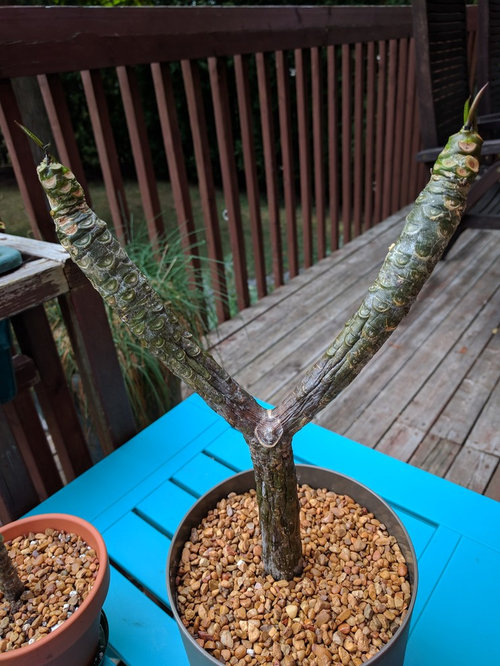
Comments (11)
Katherine
Original Author6 years agolast modified: 6 years agoI did as you suggested and watered it. The soil was warm beneath the dressing but it didn't feel wet or damp. It might be as simple as being dehydrated (here's hoping).
I just get worried - especially in the middle where it's super wrinkled. How often should I be watering a cutting like this when it's in the 25 degrees or more range?Related Professionals
Fillmore Landscape Architects & Landscape Designers · Middle Island Landscape Architects & Landscape Designers · Edmond Landscape Contractors · Beachwood Landscape Contractors · Haverhill Landscape Contractors · Maywood Landscape Contractors · National City Landscape Contractors · Oak Forest Landscape Contractors · Painesville Landscape Contractors · York Landscape Contractors · Annapolis Siding & Exteriors · Gurnee Siding & Exteriors · Oregon City Siding & Exteriors · Rahway Siding & Exteriors · Wareham Siding & Exteriorselucas101
6 years agoI forgot to clarify but this is a rooted plant, not just a cutting with no roots, right? No roots = nothing to absorb water. I'm advising for a rooted plant & if this is not rooted you need to inspect the end & check for sure if it's rotting. It looks dehydrated either way though.
Get a wooden chopstick to stick in the soil & you'll have a more accurate idea of how wet the soil is throughout the pot, deeper than your finger will go. That way you'll really know if the soil is wet or dry for sure.
When it's really hot & the plant is getting a lot of sun I water 2 or 3 times a week. If your soil is very well draining the plant should tolerate that well. (If you don't currently amend your potting soil, I recommend adding a LOT of perlite, it helps tremendously)
I hope this helps, let me know about the roots!
Katherine thanked elucas101Katherine
Original Author6 years agoIt does have roots but not very many. The cutting DID start rooting at some point (and I assume still is), but it's certainly not a root ball. I honestly don't know what the root growth rate should be for a cutting starting out either.
The bottom of the stem where the roots are is NOT soft but firm, so I think I can safely rule out stem rot. I know my other cutting looked similarly wrinkled but when i caught off the bottom, it was clear it had started to rot.
The weather is fairly hot and humid so I watered it early yesterday and again this morning and misted it as well. It's in the sun for at least 6 hours a day so I'm keeping an eye on it. I have a lot of perlite in the soil mix and it's draining well. The rocks on top are keeping it nice and toasty warm as well.
If it's currently dehydrated, should I stick to a 2-3 times a week schedule? Also, you mentioned not bringing in your plumeria till it was 10C. I didn't think that was even a possibility! I guess I brought it in prematurely. It's now sitting outside again.elucas101
6 years agoOk good, then at least it has some roots to absorb water, it's not soft at the base and you have perlite! You're set up for success so you're doing great! I would also lessen the amount of sun it gets or dappled sunlight is excellent, until it recovers. I would water it when the soil has dried out a bit which should be about every 3 days but you'll have to check.
I bring my plants in for the winter when it is consistently 50- 55F or below at night so for you 10-12C. You could do 15C just to be extra safe or for young plants. If your temps get cool you will reduce watering. (But remember, you will be checking with your chopstick to make sure the soil on the dry side before watering again!)
Good luck, keep us posted!
the_first_kms2
6 years agoIn Addition to what E posted...Any chance when you do bring it inside you can wrap or place the container on a heat mat?
Katherine
Original Author6 years agoI think it's done for. I'm absolutely devastated. This was my second attempt at growing plumeria from cuttings. I may give up if this one fails to survive.
I had all my hopes placed on this last surviving cutting. It had actually grown a flower, had full healthy leaved for most of the summer - a beauty. I was hoping to see more flowers next summer.
I had seen a suggestion someone had posted on line about how wet paper towels around the shriveled areas helped recovery. I tried it for a couple days and then took them off today. There were some hideously brown areas which rang alarm bells.
After small pin pricks to check for sap and finding none, I had to cut off the roots (it had rooted! Nooooo!) to be sure. Below is what I'm looking at.
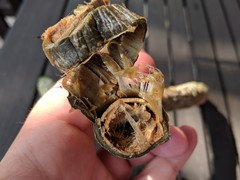
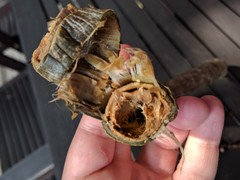

You can see the top branches are still healthy and I pin pricked one the other day and it had white sap.
What's the diagnosis friends?elucas101
6 years agoOh wow, I am so sad to see that :( You can try to save it but I'll be honest, it is hard to stop rot that advanced. More so that the plant is very dehydrated at this point and may not have the strength to make it through the time it takes to callous and root. But you can try!
Although it will most certainly not make you feel better right now, I will say we have all been where you are right now. I can STILL have cuttings that won't root even after growing for years. Don't be too hard on yourself, I know it feels awful.
Don't give up on owning plumeria if you really love them - you can always buy rooted plants and skip this entire process if it is just too frustrating - many experienced growers do this anyway just so they don't have to deal with it / so they can get their plant already ready to go.
I will send you some free cuttings in the spring for just postage if you decide you want to try again.
Something went awry here and that may not even be your fault. A few key tips may help set you up for success in the future and possibly shed light on what might have gone wrong.
#1) The foundation of rooting any cutting is to make sure you have a good callous to start with. After it is cut the cutting must be allowed to sit for at least 10-14 days to scab the end so it is nice and hardened over. Cut the leaves off the cutting. Leaves drain moisture from it while it's trying to root.
#2) Root the cutting in a smaller container such as a Gatorade bottle or something of that size, with drainage holes drilled in the bottom. A clear container will also eliminate doubt as to when it has rooted, you will see them. This helps stop the temptation to pull it out and check to see if it rooted. The smaller container as opposed to a pot will also hold less moisture after that one initial watering.
#3) A well draining soil (or some even root in pure perlite) - potting soil of any kind needs to be amended for plumeria. I can't emphasize this enough. You should have at least 50% or more perlite to your potting soil, probably even more. If you have water retentive soil and it does not dry out quickly the plumeria does not like that at all.
#4) A well draining pot. Do not let the plant grow in a container without adequate drainage holes, do not let the plant sit in a saucer or tray with water in it.
#5) Warmth. A rooting cutting has a much better chance if it is kept warm (not hot), bottom heat helps a lot such as a heat mat, warm concrete, etc. It doesn't need a lot of sun while it is trying to root, this can be too stressful.
After you're calloused and your container and well draining medium is all set, get something to stake the plant with. Optional is to wet the end and dip in rooting hormone. Pot and stake the cutting and water it one time, thoroughly until the medium is all wet.
And then you wait. Keep it warm. Do not water it again until you see roots in the container.
Again, so sorry for your loss of all that hard work and hope. Hopefully this info helps you or someone else in the future to root a cutting. :)
Katherine
Original Author6 years agoI appreciate your kind words and your offer to send me more cuttings. Might not be doable in any case as I am in Canada and I'm not sure what the rules are for mailing such things.
I guess I'm feeling a bit downhearted about it because this was a plant I really wanted to cultivate. I visited Hawaii almost a decade ago and fell in love with the plumerias. I didn't even realize growing them in Canada was a possibility until a couple years ago. In all honestly, I have a bit of a black thumb when it comes to most plants and while I was as attentive as I could be to these ones, I just cannot seem to get it right.
I have not seen more settled plumerias sold here otherwise I would consider skipping the growth of cuttings altogether. I may have to do more research into the matter.However, I don't give up easily. I just feel badly that such a hardy plant met an unfortunate end at my hands.
In the end, these photos below are all that's left of my cuttings.
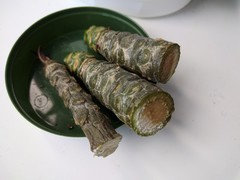
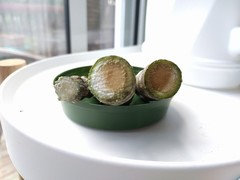
I don't even know if the right two (from the big one) are salvageable. Or if I need to but them even further down.
Also, what's the best way to sanitize the tool I'm cutting with? Just in case I'm doing it wrong?
The one on the left still might be. I'm going to let them sit and callous over or die as the case may be.
I wish I had put them in clear containers at the beginning. That's a fantastic idea and I've seen it done with other plants. Would've eliminated any doubts early on.
The window that these cuttings are currently sitting in is south facing. It gets sun for a good percentage of the day so I may move them to where my succulents currently are.
I don't have a heat mat or heat lamp - everything was kept warm through the dressing and exposure to the sun. I don't even know what a heat mat for plants would look like tbh.
I'm glad you're posting info and that I took the time to take photos and ask questions. In fact I'm really glad for this forum and for the awesome people who are trying to help and educate. I'm sure I'm not the only one who will want to grow plumerias and if you're a newbie like me, things can go south very quickly, and you won't know why. At the very least, I'm getting an education.
So to anyone reading this thread in the future, hopefully this was helpful!
I will try to salvage these cuttings if I can and then restart my rooting in the spring.Katherine
Original Author6 years agoBonus: From better days.
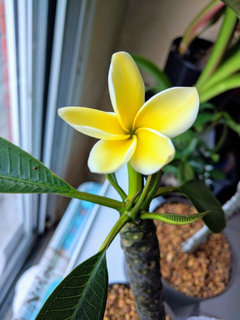
Didn't expect it to flower. At least according to the internet. I got lucky and it smelled delightful.
the_first_kms2
6 years agoSorry it happened. I think all of us at one point have had plants which we thought made it through the hard stuff only to be surprised by a very quick turn of events.






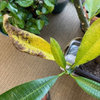
elucas101